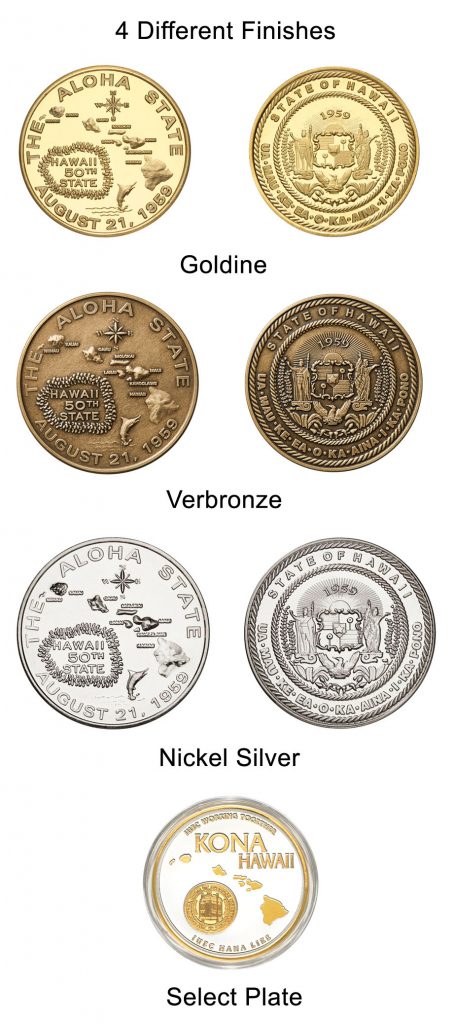
How Dies are Used in the Coin Making Process
One of the benefits of die struck coins is that the same pair of dies can be used with different metals and finishes can be applied, giving a coin a whole new look. Thus, multiple finish options with 1 pair of dies.
Coins are made with two dies – one die per side. Dies are round “blocks” of hardened metal with a flat top and a base shaped to lock into a coining press. The final image for the coin is cut – IN REVERSE – into the flat top of the die. The image can be 2 dimensional, multi-dimensional or 3 dimensional, depending on the customer's wishes. After the image is cut into the surface, the die is baked in a super-hot oven and gradually cooled. This process allows the die to withstand the multi-ton pressure used to crush the design into a blank metal disc. Thus the term “die struck” coins or tokens.
At the press, a metal disc is placed between 2 dies. The dies smash together and the metal of the disc (commonly referred to as a blank or planchet) is forced up and out – and into the dies. The resulting coin has a raised and readable image as opposed to a sunken mirror image with backward text.
Die Inspections Make a Difference in the Final Product
Repeated use is possible because dies are made from hardened steel that we purchase for the sole purpose of striking coins. Eventually, the dies wear down or the metal fatigues, and the image on the coin becomes less crisp. In some cases, a die actually cracks. All dies are inspected for wear and tear before each run and again when they're put away to ensure their quality. Coins are inspected during the run by the machine operator, who is specially trained to look for issues that could result in a less than satisfactory coin. If there is a problem with the quality of the dies, or they crack, they are replaced at no charge.
Because of the way dies are made, any changes once they are hardened means making a completely new die. Even something as small as changing 2019 to 2020 means the die must be re-made. For this reason, a final review of the provided layout is critical.
How Using the Same Pair of Dies Achieves Multiple Looks
 With that short primer on coin minting, we can discuss how the same pair of dies can achieve multiple looks.
With that short primer on coin minting, we can discuss how the same pair of dies can achieve multiple looks.
- Use different metals. We stock copper, fine silver, nickel silver, brass and aluminum.
- Once a coin is struck, it can be antiqued. All the metals we use, except aluminum, can be antiqued.
- Antiquing is a process where the coin is dipped in a chemical bath that darkens the entire surface, then it’s buffed or tumbled to eliminate some of the dark color, leaving the surface lighter and any deep or intricate detail darker.
- Coins can be colorized – all our metals except aluminum can be colorized. This is great for fine detail or photos.
- Aluminum coins can be anodized (or colored) with bright, permanent colors like purple, red, green or gold.
- Fine silver coins can be select plated.
Talk to our sales specialists to see what would work best for your design and budget.
Interested in seeing more information about custom coins?
Here are some additional resources:
- How Small is Too Small When it Comes to Coin Text Size? A short introduction to font size on coins.
-
How to tell the difference between page turn and coin turn? Depending on how you turn it, the image is upside down or right side up. What's up with that?
- Learn the Difference Between Plain and Reeded Edge Coins. Edges matter.
- How Custom Coins are Made - a video tour of the oldest private mint in America
.png)
